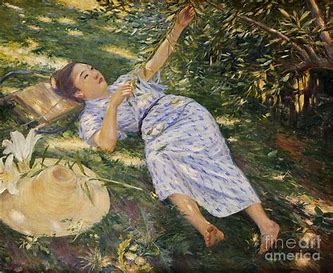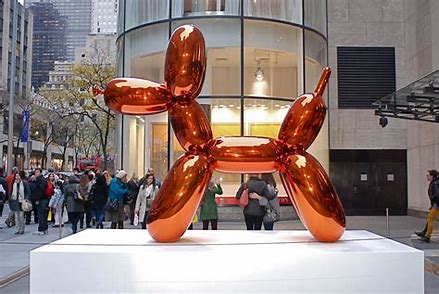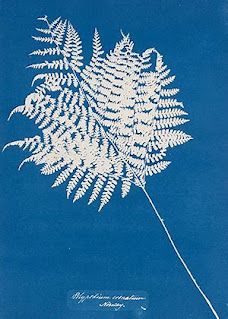Non Western Blog: Yōga Art
In this week's blog, I would like to introduce three Yōga style paintings. Yōga is an art movement that reflected modernization/westernization that was occurring in the last half of the 19th century in Japan. The Seiyōga or Yōga is often translated as "Western-style" painting. However, Yōga art is much more than a duplicate of Western art. "It was only in the aftermath of the Second World War that yōga came to be regarded as a unique genre within modern Japanese art." (Yokoyama, 2023)
In 1853, U.S. Commodore Mathew Calbraith Perry brought his fleet to Japan under orders from President Millard Fillmore, demanding entrance to their ports. Japanese authorities were so impressed by the advanced technology of the Western world that they implemented a policy of opening the borders of Japan and adopting and researching some Western traits to accelerate Japan's advancement. The historical background to Yōga art development can be traced back to 1855 Bansho Shiribesho when a translation and research institute for Western studies was established. "In 1876, the Kobu Bijutsu Gakk (Technical Art School) was established by the Meiji government as Japan's first dedicated Yga art school. Foreign advisors, such as the Italian artist Antonio Fontanesi, were hired by the government to teach Japanese artists, such as Asai Ch in the latest western techniques." (Meiji - Yōga, n.d.)
Yōga art has mostly been defined by foreign medium and formats (oil on canvas, watercolors, pastels, or pencils on paper). Yōga is an integration of Western art within Japanese culture and Japans world view, creating a distinct, new style. "As an essential component of an emerging Japanese national art, Yōga was transformed from a scientific, utilitarian tool of dubious aesthetic merit to an ambitious artistic arena for elucidating national character and demonstrating Japanese mastery of international (Western) cultural standards. Such was the work of painter, educator and arts administrator Kuroda Seiki (1866–1924), who in works such as Under the Trees combined identifiably Japanese subject matter with an Impressionism-inflected academicism learned in Paris." (Three Movements You've Never Heard of, 2017)
Kuroda Seiki's (1866–1924) painting Under the Trees is the first artwork in this week's blog. The impressionist mood of this painting caught my attention when I was conducting background research on Yōga art. The painting is oil on canvas 78 x 93.7 cm, created in 1898. It is housed at the Woodone Museum of Art, Hatsukaichi, Hiroshima, Japan. The artwork depicts a young woman lying on the ground under a tree in an attempt to pick a fruit from a silverberry tree. The painting is executed in an impressionist style, capturing a moment of total relaxation on a sunny day surrounded by nature and bathed in diffused light reflected from the plants and the ground around the resting female figure and changing the colors into cool and contrasting warm hues. The direct light provides a nice texture and balance to the composition. The subtle use of the warm sunlight and the reflected diffused sunlight beams creates an idyllic, carefree, and peaceful atmosphere while the sunlight dapples the ground, woman's face, and dress. The painting flirts with the senses while light and vibrant colors unveil the fleeting feeling of this tranquil and fragile scene.

My second artist is Wada Eisaku (1874 - 1954), and his painting Old Woman 1908. It is oil on canvas 94.0 x 136.5 cm and is housed in the National Museum of Modern Art in Tokyo, Japan. This painting depicts an old woman plagued by round back, supporting herself on an umbrella and walking along the vast body of water that reflects the light of the setting sun. The old woman is presented to the viewers in profile with her left hand using the long umbrella as a cane while looking at the dirt road under her. The visible part of the shore reflects the radiant gold and rosy light of the sun that comes from the right side of the canvas and intersects the horizontal line of water. The painting has several horizontal lines of water and land, which are intercepted by the vertical lines of the woman's figure and the sunlight. The painting's subject presents a modest person in ordinary activity but simultaneously juxtaposes the sublime beauty of the landscape with the fragile human frame. The artwork's technique is almost photographic and shows a strong influence of naturalism. The painting's mood is very tranquil and calm, depicting the woman in traditional Japanese clothes enjoying the sunset of her life.
The third and final artist and painting I would like to present is Kitawaki Noboru (1901 - 1951) and his painting Quo Vadis 1949. It is oil on canvas, measures 91.0 x 117.0 cm, and is housed at the National Museum of Modern Art, Tokyo. It is a surrealist painting that depicts a male figure in a baron landscape submerged in an endless area of white color intercepted by a blue rain cloud on the upper right side of the painting, dispersing rain upon a distant city. In the center of the painting, the male figure with his back to the viewer, wearing worn clothes and a rucksack, holds a book under his left arm and is positioned between the shell of a giant snail and a direction maker with little flowers growing underneath it. In front of the human figure is an endless zigzag of tiny human figures marching forward. The painting's title gives a clue to the meaning of the painting, reflecting on the artist's search for direction in life and the emptiness of the post-WWII landscape. The painting has ambiguous associations with existentialism, capitalism, and the destiny of the human race.

Works cited
“Meiji - Yōga.” History of Creativity , www.historyofcreativity.com/mid111/meiji--yga. Accessed 24 Apr. 2024.
“Old Woman (コレクション).” The National Museum of Modern Art, Tokyo, www.momat.go.jp/en/collection/o00024.
“Three Movements You’ve Never Heard of: Yōga Painting, Nabis, Juste Milieu.” Artspace, 23 Mar. 2017, www.artspace.com/magazine/art_101/book_report/three-movements-youve-never-heard-of-yoga-painting-nabis-juste-milieu-54594.
Yokoyama, Yukiko. “A History of Western-Style Yōga Painting in Japan and Women Yōga Artists from the Meiji Period to the Pre-War Era.” AWARE Women Artists, 21 Apr. 2023, awarewomenartists.com/en/magazine/le-style-occidental-au-japon-yoga-et-les-peintres-japonaises-entre-louverture-du-japon-en-1868-et-la-deuxieme-guerre-mondiale/.



This is so interesting to see Japanese art integrate a Western style approach. Japanese art has such a distinct look and while there is major differences within the 3 pieces you’ve chosen to showcase, it still has some similar characteristics. I see nature depicted in many Japan based artworks and there is no difference here. I think that is one of the reasons I was drawn to the first work, “Under the Trees”. It feels so inviting and calm. The perspective that the artist chose to paint the woman from makes the viewer feel like a friend or lover and we are put into the position of admiring the woman below, while she admires the plants surrounding her.
ReplyDeleteI really enjoyed your blog. It was interesting and It taught me something new. I like how delicate the paintings look. It’s like you can feel how the person is feeling. For example, in the second painting, it makes me feel tired by how the women in hunched over.
ReplyDeleteHello Chris,
ReplyDeleteIn the first painting the woman looks so relaxed with the sunlight filtering through the trees, her shoes discarded, and her hat tossed aside. This is a painting I would like to own. The scene is painted to look so tranquil with way she is lounging back. She looks like she doesn’t have a care in the world. The expression on her face is content.
The second picture, while a little difficult to look at with the condition of the poor woman’s back, it is heartwarming to know that she still goes out and takes a walk while the sun sets on the horizon.
I am having difficulty figuring out what exactly the point is to the last one. I can’t connect anything in the picture except that the gentleman is watching the people walking in the distance. Unless he is incredibly small that is one giant snail, he is standing next to.
Chris ; Under the Trees paintings by Kuroda Seiki and Wada Eisaku Old Woman are paintings that are very life-like. I love the naturalism in both paintings and under the trees is so relaxing. Makes me want to lay in the grass as the sun rises. The old woman seems like she has been through tough times. The last painting was a little confusing to me. Other than the rain and an old man with the ruck sack, I don't really understand it.
ReplyDelete